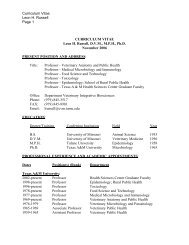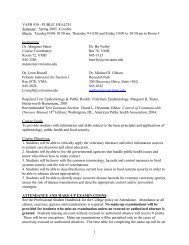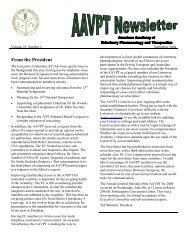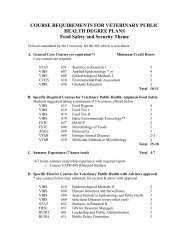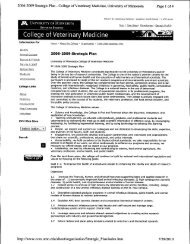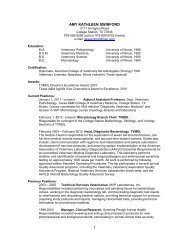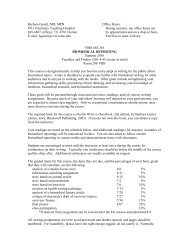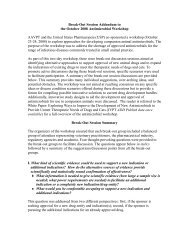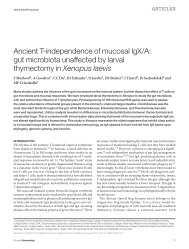Disaster - College of Veterinary Medicine - Texas A&M University
Disaster - College of Veterinary Medicine - Texas A&M University
Disaster - College of Veterinary Medicine - Texas A&M University
You also want an ePaper? Increase the reach of your titles
YUMPU automatically turns print PDFs into web optimized ePapers that Google loves.
Faculty/Staff Focus<br />
Altering the architecture <strong>of</strong> malignant cells may slow cancer<br />
CCancer may spread throughout the<br />
human body when malignant cells<br />
travel in the blood stream. But it may<br />
be possible to slow or even stop those<br />
cells from spreading by altering their<br />
structure, according to a recent investigation<br />
led by a <strong>Texas</strong> A&M <strong>University</strong><br />
researcher.<br />
The team, lead by Dr. Gonzalo<br />
Rivera, an assistant pr<strong>of</strong>essor in the<br />
department <strong>of</strong> veterinary pathobiology<br />
at the <strong>Texas</strong> A&M <strong>University</strong> <strong>College</strong> <strong>of</strong><br />
Dr. Gonzalo Rivera<br />
Dr. William J. Murphy, associate pr<strong>of</strong>essor<br />
in the Department <strong>of</strong> <strong>Veterinary</strong><br />
Integrative Biosciences at the <strong>Texas</strong><br />
A&M <strong>University</strong> <strong>College</strong> <strong>of</strong> <strong>Veterinary</strong><br />
<strong>Medicine</strong> & Biomedical Sciences, is<br />
this year’s recipient <strong>of</strong> the JoAnn Treat<br />
Research Excellence Award.<br />
Established by The Board <strong>of</strong> Trustees<br />
<strong>of</strong> the <strong>Texas</strong> A&M Research Foundation,<br />
the award is open to faculty at any<br />
<strong>of</strong> The <strong>Texas</strong> A&M <strong>University</strong> System<br />
components. It recognizes exceptional<br />
contribution to the faculty member’s<br />
field <strong>of</strong> research, administered through<br />
the Foundation, during the past five<br />
years. The award is named in honor<br />
<strong>of</strong> JoAnn Treat, who served 19 years as<br />
president <strong>of</strong> the Research Foundation<br />
before retiring in August 2003.<br />
The Foundation announced the<br />
award at their annual councilor/<br />
trustee fall meeting held on December<br />
11, 2009. Murphy received a $10,000<br />
award and a commemorative plaque.<br />
He will also have his name recorded on<br />
42 • CVM Today • Summer 2010<br />
<strong>Veterinary</strong> <strong>Medicine</strong> & Biomedical Sciences<br />
(CVM), and including scientists<br />
from The <strong>University</strong> <strong>of</strong> Connecticut<br />
Health Center and the <strong>University</strong> <strong>of</strong><br />
California, San Francisco, published<br />
its findings recently in Molecular Cell, a<br />
peer-reviewed scientific journal.<br />
The spread <strong>of</strong> cancer is one example<br />
<strong>of</strong> what can happen when things go<br />
awry with the cytoskeleton, a meshwork<br />
created by the assembly <strong>of</strong> multiple<br />
copies <strong>of</strong> a cellular protein called actin,<br />
Rivera explained.<br />
The actin cytoskeleton determines<br />
a cell’s shape and its ability to stick to<br />
other cells or to tissue. The cytoskeleton<br />
is constantly being reshaped in<br />
response to external clues sensed by<br />
cells. Through a complex process <strong>of</strong><br />
“signal transduction,” cells translate<br />
external clues into specific behaviors.<br />
They may grow rapidly, alter their functions<br />
or may migrate to other parts <strong>of</strong><br />
the body.<br />
Cells respond to signals from the<br />
environment in several ways. Among<br />
the most critical are the changes in<br />
lipids called phosphoinositides as well<br />
as in tyrosine phosphorylation, the addition<br />
<strong>of</strong> a phosphate group to specific<br />
cellular proteins.<br />
the JoAnn Treat commemorative glass<br />
vase displayed in the Research Foundation<br />
lobby.<br />
Murphy’s main research interests<br />
are feline genomics and mammalian<br />
phylogenetics.<br />
“Mapping the feline genome will<br />
facilitate the identification <strong>of</strong> genes<br />
involved in feline diseases and should<br />
have a major impact on improving feline<br />
health,” he said. “It will also enable<br />
the use <strong>of</strong> the domestic cat as a model<br />
for human disease.” Murphy’s research<br />
also focuses on mammalian phylogenetics<br />
and conservation genetics.<br />
Murphy received his PhD in biological<br />
sciences in 1997 from Tulsa <strong>University</strong>.<br />
He completed his postdoctoral<br />
work at the Laboratory <strong>of</strong> Genomic Diversity<br />
<strong>of</strong> the National Cancer Institute,<br />
and worked as a senior scientist at NIH<br />
before joining <strong>Texas</strong> A&M <strong>University</strong><br />
in 2004. He has published over seventy<br />
articles in peer-reviewed journals,<br />
including Science and Nature. His lab<br />
“The long-term goal <strong>of</strong> our research<br />
is to define how signals that alter the<br />
cytoskeletal architecture promote cancer<br />
initiation and progression, as well<br />
as migration <strong>of</strong> vascular cells,” Rivera<br />
said.<br />
Using a unique combination <strong>of</strong><br />
experimental approaches, including<br />
molecular genetics, proteomics, and<br />
high resolution optical microscopy,<br />
Rivera and his co-investigators uncovered<br />
a novel molecular mechanism in<br />
the regulation <strong>of</strong> N-WASp, a protein<br />
critically involved in rearrangements <strong>of</strong><br />
the actin cytoskeleton.<br />
N-WASp is a direct cousin <strong>of</strong> WASp<br />
(Wiskott-Aldrich Syndrome protein), a<br />
protein named after the physicians that<br />
first reported a rare inherited disorder<br />
characterized by low level <strong>of</strong> blood<br />
platelets, eczema, recurrent infections,<br />
and a high risk <strong>of</strong> leukemia or lymph<br />
node tumors in boys.<br />
The article, “Reciprocal Interdependence<br />
between Nck and PI(4,5)P2<br />
Promotes Localized N-WASp-Mediated<br />
Actin Polymerization in Living Cells,”<br />
can be found in the Nov. 13, 2009, issue<br />
<strong>of</strong> Molecular Cell.<br />
Murphy wins JoAnn Treat Research Excellence Award<br />
Dr. William J. Murphy<br />
is funded by the National Science<br />
Foundation, USDA, Morris Animal<br />
Foundation, AKC-Canine Health Foundation,<br />
Winn Feline Foundation, The<br />
Snow Leopard Conservancy, and the<br />
National Geographic Foundation.




